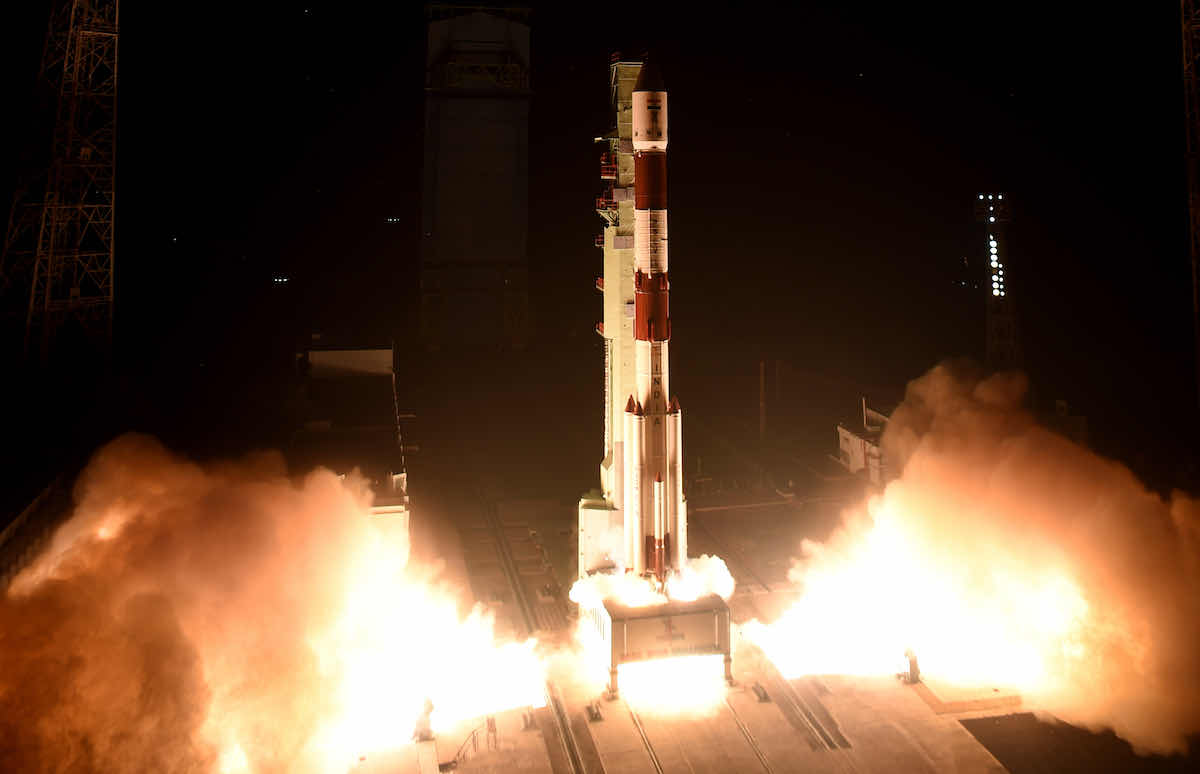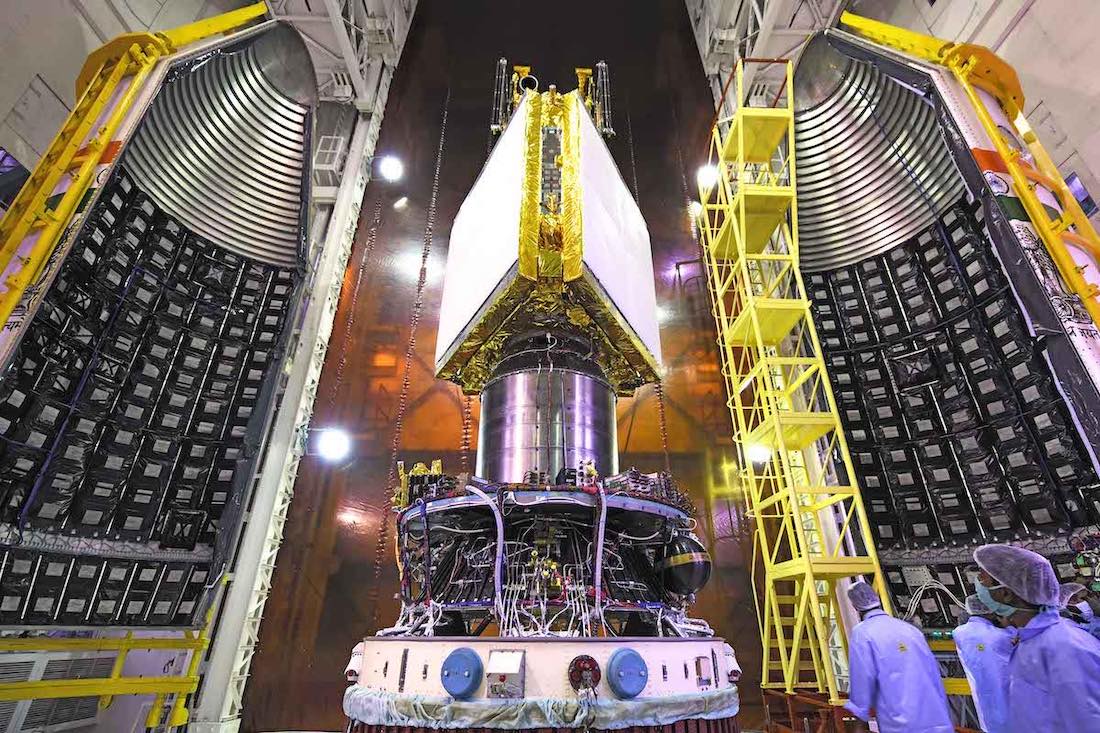Space News & Blog Articles
India orbits three satellites in first space launch since failure
 India’s Polar Satellite Launch Vehicle lifts off with the EOS 4 radar satellite. Credit: ISRO
India’s Polar Satellite Launch Vehicle lifts off with the EOS 4 radar satellite. Credit: ISRO
An Indian radar satellite and two rideshare payloads rode a Polar Satellite Launch Vehicle into orbit Sunday, returning India’s space program to flight after the failure of a different type of rocket last August.
The mission lifted off from the Satish Dhawan Space Center, located about 50 miles (80 kilometers) north of Chennai on India’s east coast, at 7:29 p.m. EST Sunday (0029 GMT Monday). Launch occurred at 5:59 a.m. local time in India.
India’s PSLV flew in its most powerful configuration, called the PSLV XL, with six strap-on solid rocket boosters. The boosters and core stage motor, also burning pre-packed solid propellants, sent the rocket downrange over the Bay of Bengal.
Four of the boosters fired to assist the core stage in the first segment of the mission. Two more air-lit boosters ignited 25 seconds later to give the rocket 2 million pounds of thrust at maximum power.
The six boosters burned out and jettisoned in the first minute-and-a-half of the mission, then the core stage consumed its propellant and separated at T+plus 1 minute, 49 seconds. A fraction off a second later, the rocket’s Vikas liquid-fueled second stage engine powered up to continue the climb into space.
The rocket shed its nose cone, then burns by the PSLV’s solid-fueled third stage and liquid-fueled third stage guided the mission’s three satellite payloads into orbit, steering the rocket southeast, then south to avoid flying over Sri Lanka.
The PSLV deployed the EOS 4 spacecraft nearly 18 minutes after liftoff. About a minute later, the rocket released its two rideshare payloads. On-board cameras showed the satellites flying free of the rocket, and officials from the Indian Space Research Organization confirmed the PSLV reached an on-target orbit.
Liftoff of the Polar Satellite Launch Vehicle, hauling into orbit the Indian EOS 4 radar remote sensing satellite, a tech demo thermal imaging spacecraft, and a space weather research satellite for US, Indian, Taiwanese, and Singaporean scientists.https://t.co/bpM3ByEAUy pic.twitter.com/X0UABGTO65
— Spaceflight Now (@SpaceflightNow) February 14, 2022
The mission aimed for a polar orbit 328 miles (529 kilometers) above Earth. ISRO officials also confirmed the main satellite on the launch, named EOS 4, deployed its solar panels to begin generating its own electrical power.
The 3,770-pound (1,710-kilogram) EOS 4 spacecraft, previously known as RISAT 1A, was expected to next deploy its C-band radar antenna. The spacecraft will collect radar images of Earth, gathering data useful in agriculture, soil moisture detection, disaster management, disaster assessment, carbon inventory, and forestry and plantation management.
Radar remote sensing satellites can see Earth’s surface in day and night, and aren’t obscured by cloud over like optical imaging missions. EOS 4 is beginning a 10-year mission.
“This spacecraft is going to be one of the biggest assets for us to serve the country,” said S. Somanath, chairman of ISRO, in remarks from the Satish Dhawan Space Center after the launch.
The INS 2TD satellite, launched as a secondary payload Sunday, carries a thermal imaging camera for Earth observations, serving as a technology demonstrator for a future satellite India is developing in cooperation with Bhutan.
INSPIRESat 1 is a joint project between the University of Colorado’s Laboratory for Atmospheric and Space Physics and the Indian Institute of Space Science and Technology, with additional contributions from institutions in Singapore and Taiwan.
It host a scientific instrument to study the dynamics of Earth’s ionosphere, a layer of the upper atmosphere where the influences of terrestrial weather and space weather come together, impacting satellite operations and radio communications.
Another instrument on INSPIRESat 1 is an X-ray spectrometer funded by NASA to observe solar flares. The INSPIRESat 1 spacecraft was assembled and tested in Colorado and shipped to India to prepare for launch.
 India’s EOS 4 radar imaging satellite is prepared for encapsulation inside the payload shroud of its Polar Satellite Launch Vehicle. Credit: ISRO
India’s EOS 4 radar imaging satellite is prepared for encapsulation inside the payload shroud of its Polar Satellite Launch Vehicle. Credit: ISRO
The launch Sunday marked the first flight of a PSLV since last February, a slowdown in India’s launch cadence partially blamed on impacts from the COVID-19 pandemic. With Sunday’s mission, India has launched 54 PSLV missions since 1993, flying as many six times in a single year after finding a niche in the international launch market to deliver small and medium-size satellites into orbit.
But India has now launched just four PSLV flights in the last two years. The pandemic forced India’s space agency to pause launch preparations, and many of the kinds of satellites once launched by the PSLV have moved to other rockets, primarily SpaceX’s Falcon 9 and emerging launchers from companies like Rocket Lab.
India’s PSLV is capable of delivering more than 3,850 pounds (1,750 kilograms) of payload to a 386-mile-high (622-kilometer) polar orbit, placing its lift capability above that of most of the commercial small launch companies, but well below SpaceX’s Falcon 9.
The launch Sunday was also the first orbital mission from India since the failure of the country’s more powerful GSLV Mk.2 rocket in August. A technical problem with the rocket’s third stage prevented it from reaching orbit with an Indian Earth observation satellite.
This email address is being protected from spambots. You need JavaScript enabled to view it. the author.
Follow Stephen Clark on Twitter: @StephenClark1.
When you subscribe to the SpaceZE News Feed, we will send you an e-mail when there are new updates on the site so you wouldn't miss them.

